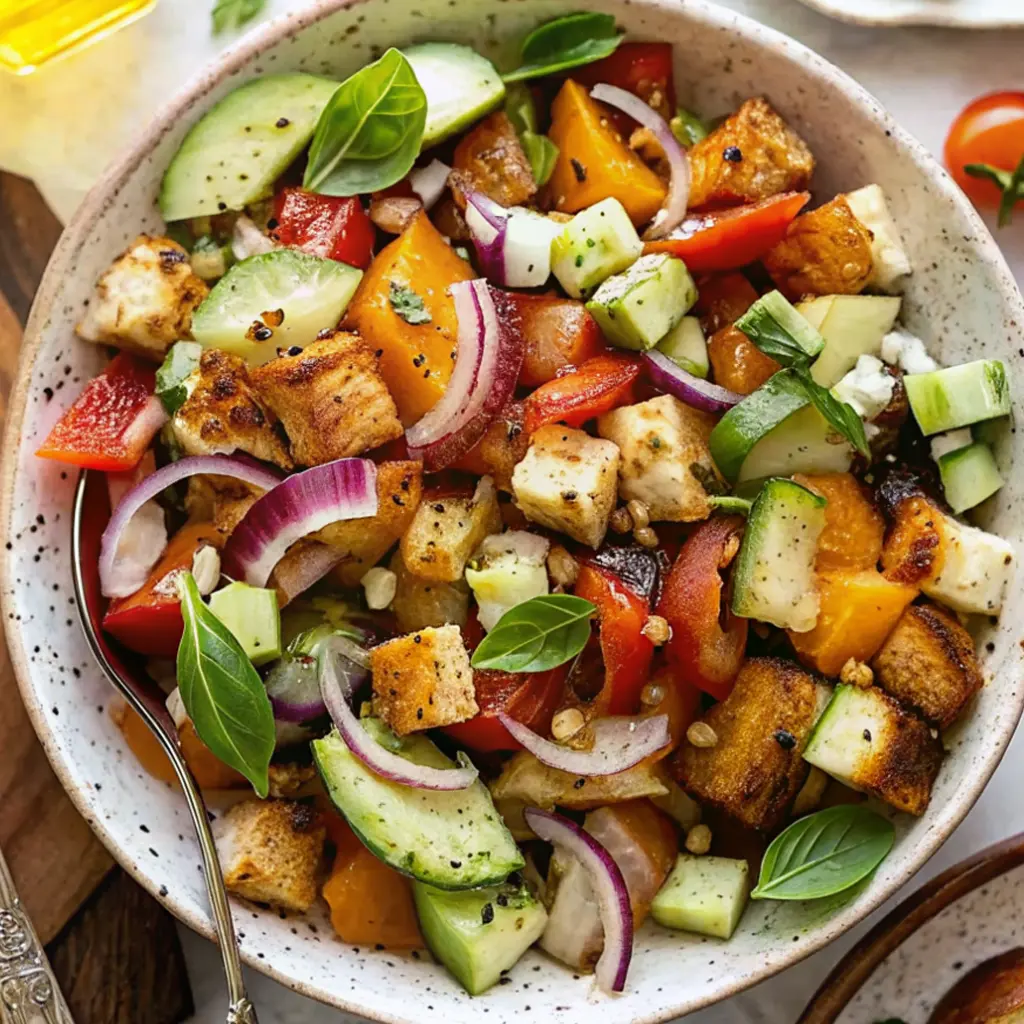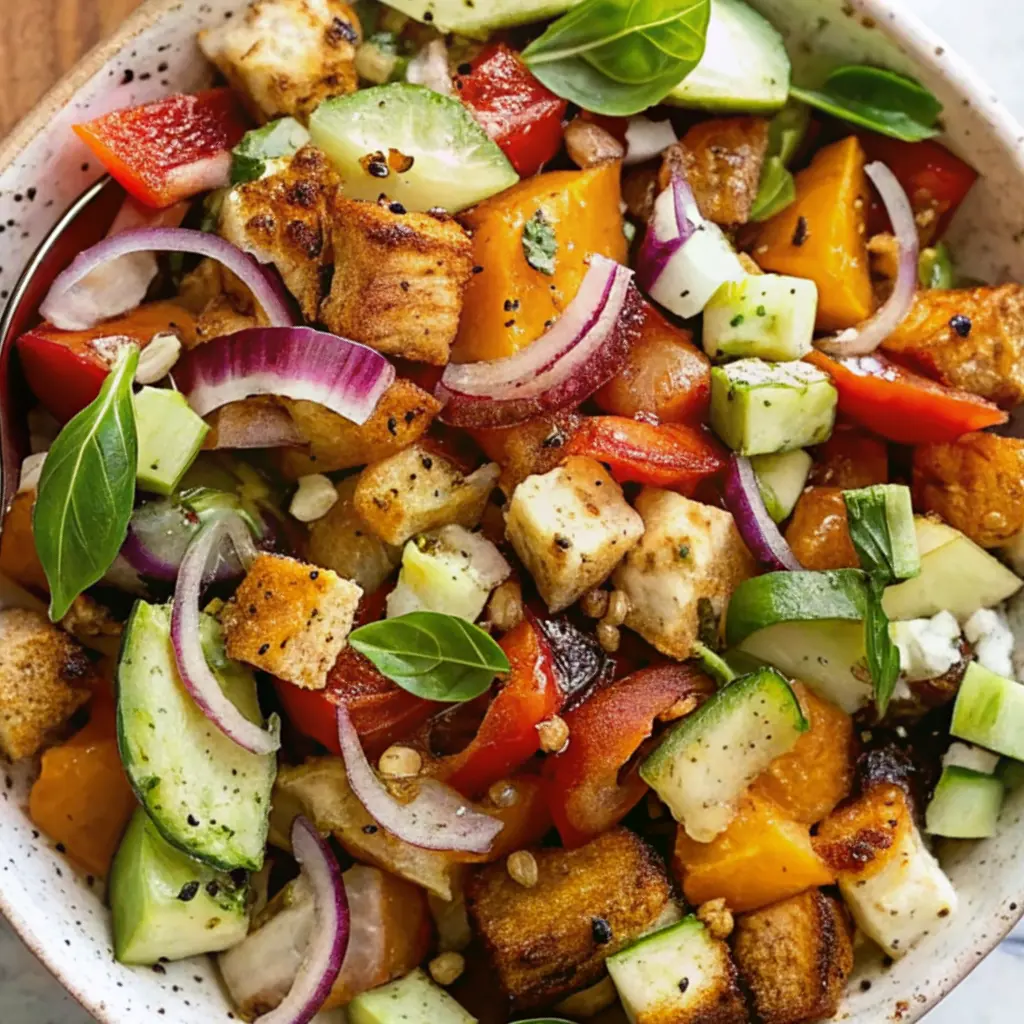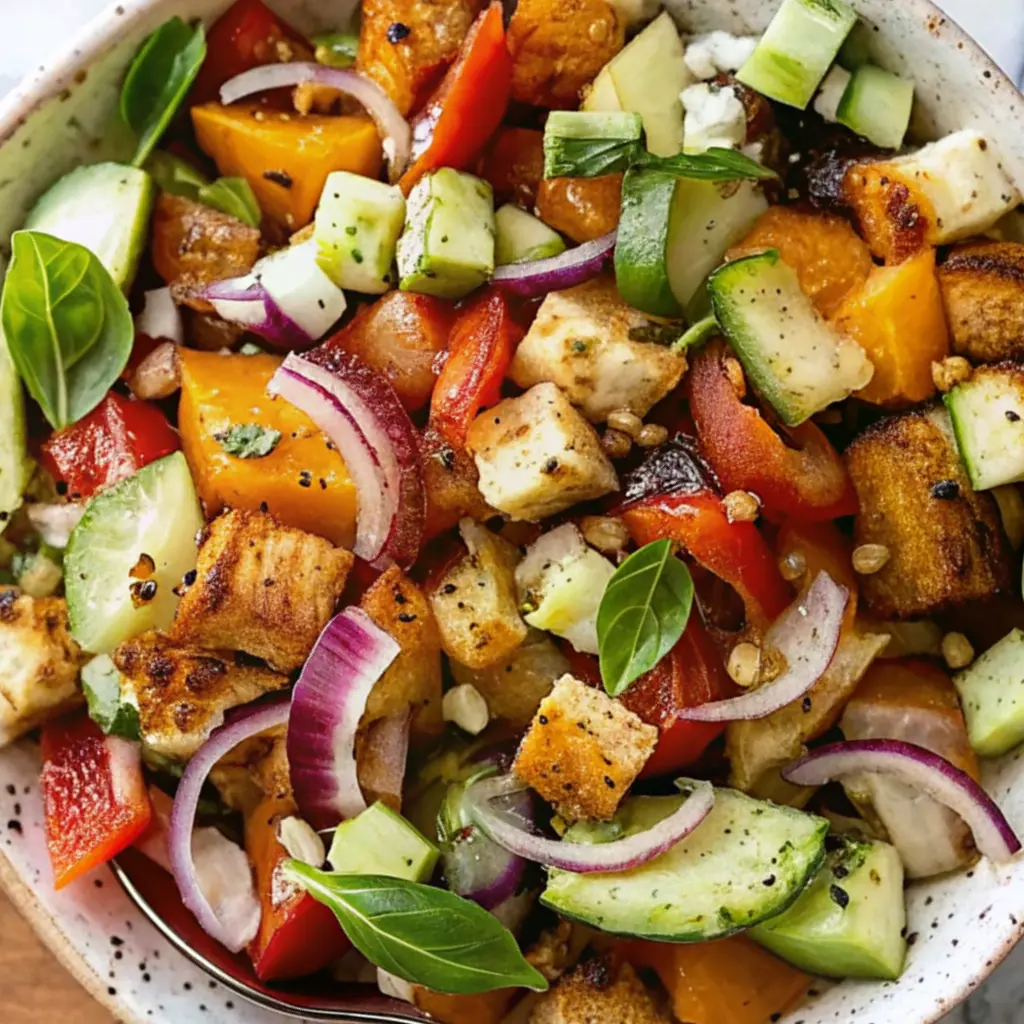I still remember the first time I made Panzanella. It was mid-July, and I’d just come home from the farmer’s market with more tomatoes than any sane person should try to carry on foot. My youngest was tugging at my skirt, sweaty and barefoot, asking for something “cold and crunchy” for lunch. I didn’t have a plan—just a counter full of ripe, bursting tomatoes, half a red onion, a few tired cucumbers, and a stale hunk of sourdough I hadn’t thrown out.
The bread had gone rock-hard, but something told me not to toss it. That’s when I remembered a salad I’d eaten years before in a little trattoria just outside of Florence. It was humble, soaked through with olive oil and vinegar, and impossibly good.
I didn’t even know what it was called back then, but standing in my kitchen that afternoon, hot and rushed, I pieced together the memory. That was the first time I made Panzanella, and I’ve made it nearly every summer since.

Why You’ll Love This Recipe:
- Uses up leftover or stale bread
- Packed with juicy, fresh summer produce
- No stove or oven required—perfect for hot days
- Even better after it sits for a while
- A crowd-pleaser that feels fancy, but isn’t fussy
Ingredients You’ll Need:
- Day-old crusty bread – I like sourdough or ciabatta, torn into bite-sized chunks. You want it at least a day old so it can really soak up the dressing. If your bread is too fresh, you can cube it and dry it out in a low oven for 10 minutes.
- Ripe tomatoes – Go for a mix of colors and shapes if you can. I’ve used everything from heirlooms to cherry tomatoes. What matters is ripeness—this salad lives and dies by the quality of the tomatoes.
- Cucumber – I usually peel it, but not always. If the skin’s thin, I leave it on for extra crunch. Slice it thin or chop it, whatever you prefer.
- Red onion – Thinly sliced and soaked in cold water for 10 minutes to mellow out the bite. This step is worth the extra bowl.
- Fresh basil – Torn, not chopped. There’s something about tearing basil with your hands that makes it more fragrant. Maybe it’s superstition, but I believe in it.
- Extra virgin olive oil – This is where you want to use the good stuff. The flavor really shines.
- Red wine vinegar – Sharp, bright, and essential. I’ve used white wine vinegar in a pinch, but red wine has more depth.
- Salt and freshly ground black pepper – Always to taste, but don’t be shy—especially with the tomatoes.
How to Make It (Step-by-Step Instructions):
Start by prepping the bread. If it’s already stale, great—you’re halfway there. Tear it into rough chunks, about the size of a walnut, and spread them out to dry a little more while you work on the rest. If your bread is still soft, you can dry it out in a low oven (around 250°F) for about 10–15 minutes. You’re not trying to toast it—just take the moisture out.
Next, deal with the onions. I slice mine paper-thin and soak them in ice water for about 10 minutes. This cuts the harshness and makes them almost sweet. While those are soaking, chop the tomatoes. I like to do a mix of wedges and rough chunks for a more rustic look. Don’t throw away the tomato juices—they’re gold. Let them sit in a large mixing bowl with a pinch of salt to start releasing their juices. Add the cucumbers and drained onions to the same bowl.
Now, toss in the bread. At this stage, the bread will look like too much, but trust me—it will soften beautifully as it absorbs the tomato juices and dressing. Drizzle in a generous amount of olive oil and a few splashes of red wine vinegar. This is where you need to taste and adjust. Does it need more salt? More vinegar? The goal is a balance of brightness, fat, and freshness.
Let it sit for at least 30 minutes at room temperature. I usually leave it for closer to an hour. Stir it once or twice so the bread gets evenly coated. Right before serving, tear in the basil leaves and give it one final toss. If the bread still feels a little dry in the middle, a splash more olive oil or a spoonful of water from the tomatoes will do the trick.

Expert Tips for the Best Results:
Time is your friend here. Panzanella isn’t a salad you serve immediately—it needs time to meld, to let the bread drink in the vinaigrette and tomato juices. I’ve rushed it before and ended up with dry bread and disconnected flavors. The tomatoes should be at their absolute peak; there’s no faking flavor with this dish. If they aren’t juicy enough, you can massage them with a little salt to coax out the juices. And when it comes to the bread, tear rather than cube. The craggy edges soak up more dressing, and the irregular shapes make each bite feel a little different.
Variations & Substitutions:
There have been plenty of times when I’ve made this salad with whatever I had on hand, and it’s nearly impossible to mess up. Once I added roasted red peppers and olives, and it turned into more of a Tuscan antipasto situation—no complaints. I’ve swapped the red wine vinegar for lemon juice when I ran out, and it gave the salad a sunnier brightness. One memorable night, I used a loaf of olive focaccia that had gone stale, and it was rich and fragrant in a way I didn’t expect. You can also toss in mozzarella, feta, or even grilled corn. This recipe is more of a canvas than a script.
Serving Suggestions:
This salad is summer on a plate and doesn’t need much else, but I often serve it alongside grilled chicken, sausages, or fish when we eat outdoors. It’s lovely with a glass of chilled rosé or even lemonade. For picnics or potlucks, I pack it in a big container and let it sit covered until it’s time to eat—it always gets better as it rests. And on lazy days, I’ve eaten it all on its own, barefoot in the kitchen, fork in hand, bowl balanced in the crook of my arm.
Storage & Reheating Instructions:
Panzanella doesn’t keep like most salads, but I do stash leftovers in the fridge, tightly covered. It’ll last a day or so. The bread gets softer, almost pudding-like, but I kind of love it that way. If you’re planning to make it ahead, you can keep the components separate and mix them about an hour before serving. I wouldn’t reheat it—it’s meant to be served cool or room temperature—but I’ve been known to add a spoonful of leftover Panzanella to a bowl of warm soup, and it’s oddly comforting.
Recipe FAQs (Answered by Clara):
Can I make this ahead of time?
You sure can. I often prepare it in the morning, cover it tightly, and pop it in the fridge. It actually tastes better after resting.
What if my bread is too fresh?
No problem—just cube or tear it and dry it in a low oven until it feels firm and a bit crunchy. You don’t want toast, just dry bread.
Is there a gluten-free option?
Absolutely. I’ve used gluten-free baguettes before and let them dry out the same way. Just make sure they’re sturdy enough to hold up to the dressing.
Can I use other vegetables?
Definitely. Bell peppers, celery, even radishes have made it into my bowl on occasion. Just aim for crisp, fresh textures that won’t get soggy too quickly.
Do I have to peel the tomatoes?
Not at all. I never do. The skin adds color and texture, and frankly, life’s too short to peel tomatoes unless you really want to.

Conclusion:
There’s something about Panzanella that feels like a celebration of what’s already in your kitchen. It’s not about perfection—it’s about ripeness, timing, and trust in simple ingredients. If you give it time and let the flavors get to know each other, this humble salad becomes something truly special. I hope you try it, tweak it, make it your own, and most of all, enjoy it. If you do, I’d love to hear about it. Leave a comment, share your version, or just let me know how it turned out. Happy cooking, from my kitchen to yours.
Nutrition Information (Per Serving):
Calories: 280 | Fat: 15g | Saturated Fat: 2g | Carbohydrates: 30g | Fiber: 3g | Sugar: 5g | Protein: 6g | Sodium: 420mg

Panzanella Salad
Ingredients
- 4 cups crusty day-old bread cut into 1-inch cubes
- 4 medium ripe tomatoes chopped
- 1 cucumber peeled and sliced
- ½ small red onion thinly sliced
- ½ cup fresh basil leaves torn
- ¼ cup extra virgin olive oil
- 2 tablespoons red wine vinegar
- 1 garlic clove minced
- Salt and black pepper to taste
Instructions
- Toast the bread (optional but recommended): In a dry skillet or 375°F (190°C) oven, lightly toast the bread cubes until golden and crisp on the outside but still chewy inside. Let cool.
- Combine the vegetables: In a large bowl, mix the chopped tomatoes, cucumber slices, and red onion. Season with a pinch of salt and set aside to release juices.
- Make the vinaigrette: In a small bowl, whisk together the olive oil, red wine vinegar, minced garlic, salt, and pepper.
- Toss the salad: Add the toasted bread and fresh basil to the bowl of vegetables. Pour the vinaigrette over the mixture and toss gently until everything is coated.
- Let it rest: Let the salad sit for about 20–30 minutes at room temperature so the bread can soak up the flavors.
- Serve: Toss again before serving. Drizzle with a little extra olive oil and garnish with more basil if desired.
Notes
- Use high-quality extra virgin olive oil and ripe, juicy tomatoes for best flavor.
- Day-old sourdough, ciabatta, or baguette works well.
- Add extras like mozzarella, olives, or capers for variation.
- Can be made 1–2 hours ahead—just don’t refrigerate, or the bread may harden.


Leave a Reply